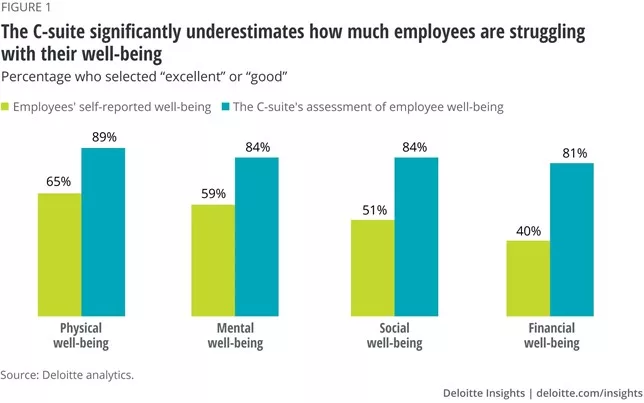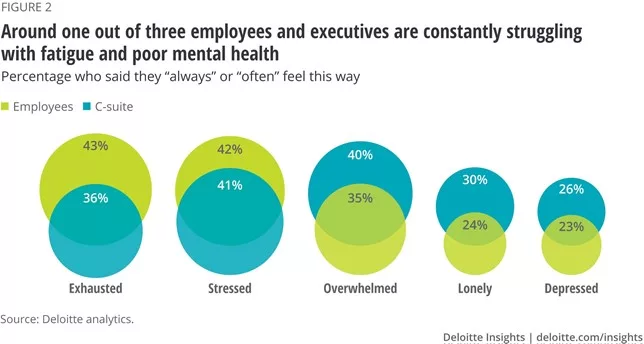Minding the gap: how the C-suite can foster employee engagement (and address their own burnout)

Employee engagement is suffering, from entry-level workers all the way up to company executives. A transparent and empathetic approach could be what’s missing.
According to the Gallup World Poll, people typically spend an average of 81,396 hours working throughout their lifetimes, and even this number is considered conservative.¹ All people have basic needs that must be met in order to thrive and, while these differ from person to person and role to role, they are true in both personal and professional settings.
A sense of burnout or disengagement at work can begin when a person’s basic needs are not met in the workplace. This lack of engagement can impact an employees’ morale, interfere with their personal lives, and ultimately damage a company’s performance and culture.
“Being miserable at work can bring more suffering to a person’s life than being unemployed,” wrote Jon Clifton, chief executive officer of Gallup, in the company’s State of the Workforce 2022 Report.
Gallup estimates more than half (57%) of the current global workforce is made up of employees who are not thriving and, therefore, are not engaged. Only 21% of global employees are engaged at work, Gallup shared, and just one-third (33%) of employees globally say they are thriving in their overall wellbeing.
Gallup defines engaged employees as “highly involved in and enthusiastic about their work,” while describing not-engaged employees as “psychologically unattached to their work and company.” Engaged employees reflect feelings that their basic needs are being met in the workplace, feel a sense of contribution and belonging, and see opportunities to fine-tune their skills and grow in the organization. On the other hand, non-engaged employees are showing up to do the work, but lack the energy or passion seen among more engaged employees.
Left unchecked, non-engaged employees can become actively disengaged employees. Actively disengaged employees are not only unhappy at work, according to Gallup, but reflect feelings of resentment that can cause them to act out of their unhappiness and, in some cases, undermine the work contributed by even their most engaged colleagues.
Today’s employees are experiencing negative emotions like stress, anger, worry or sadness throughout the day. When these symptoms are not addressed — or ignored — by an employer, they can result in a non-engaged or actively disengaged workforce. According to Gallup’s State of the Global Workplace 2022 Report, 44% of global employees reported feeling stress during “a lot” of the previous day, and 40% reported feeling worry to the same extent.
“Executives everywhere should want the world’s workers to thrive. And helping the world’s workers thrive starts with listening to them,” Clifton wrote.
Herein lies the crux of the issue. According to a report by Deloitte Insights, C-suite executives tend to significantly underestimate the wellbeing of their employees while overestimating their employees’ perception of how wellbeing is prioritized in the workplace.
For example, more than 80% of C-suite executives ranked their employees’ overall wellbeing as “excellent” or “good.”² When employees were asked to rank their own wellbeing, responses for “excellent” or “good” averaged 54%, with financial wellbeing representing the widest gap between employee-reported wellbeing and C-suite perception of wellbeing.

Additionally, 91% of C-suite executives say their employees know that company leadership cares about their wellbeing, but only 56% of employees actually believe their wellbeing is being prioritized, according to Deloitte.
Nearly 90% of C-suite executives reported improving wellbeing as a top priority in 2023. However, in order for company leadership to achieve this goal, they must also consider their own wellbeing.
Deloitte Insights reports a significant number of both employees and C-suite executives are “constantly struggling” with feeling exhausted, stressed and overwhelmed, with a smaller but still significant number experiencing near-constant loneliness or depression.
According to the report, 43% of employees say they “always” or “often” feel exhausted, compared to 36% of C-suite executives; 42% of employees feel stressed, compared to 41% of the C-suite; and 40% of the C-suite feels overwhelmed, compared to 35% of employees.

Deloitte offered two opportunities for company executives to support wellness in the workplace: transparency and benefits. Over the next one to two years, 83% of company leaders said they plan to improve or expand the wellbeing benefits they offer employees. Some of these efforts include requiring employees to take time off, with 27% even offering a supplemental stipend to employees for time taken off. In addition, 35% of leaders require employees to take breaks throughout the day, and 20% have implemented a ban on emailing after work hours. However, less than 40% of all company leaders said they have already put policies like this in place, which suggests there is still plenty of room for improvement.
Regarding transparency, Deloitte shared 84% of C-suite executives are holding forums or discussions with employees to understand where wellbeing efforts may be falling short. However, while 73% of C-suite executives say they are disseminating information about wellbeing, only 22% of employees are seeing and recognizing these efforts. Again, there is ample room for improvement here.
As employers seek a more wellness-focused approach in the workplace, it’s important to remember that employees are people, first and foremost. This makes empathy one of the most valuable tools in a leader’s shed.
To combat suffering engagement in today’s fast-paced workplace, company leaders will do well to take ownership of — and advocate for — their employees’ wellbeing as well as their own.
Sources:
[1] Gallup (2022). State of the Global Workplace 2022 Report: The Voice of the World’s Employees. Retrieved January 28, 2023, from https://www.gallup.com/workplace/349484/state-of-the-global-workplace-2022-report.aspx. [2] Deloitte (2022). The C-suite’s role in well-being. Retrieved Jan. 28, 2023, from https://www2.deloitte.com/us/en/insights/topics/leadership/employee-wellness-in-the-corporate-workplace.html.